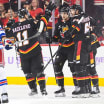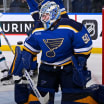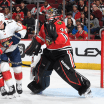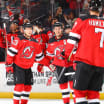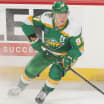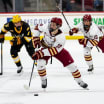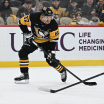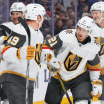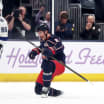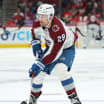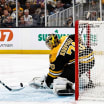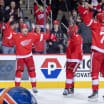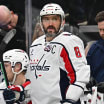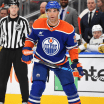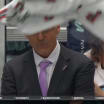St. Louis will take its place at the center of the hockey world on Jan. 2, when all eyes will be focused on Busch Stadium for the 2017 Bridgestone NHL Winter Classic.
The game between the Blues and Chicago Blackhawks at the home of baseball's St. Louis Cardinals will be the exclamation point of a 50-year journey of professional hockey in St. Louis that began when the Blues arrived in the NHL as an expansion team and continues today.
Winter Classic highlights hockey's rise in St. Louis
Brett Hull, Blues alumni network have accelerated sport's emergence

© Scott Rovak/Getty Images
More than 43,000 fans are expected to jam the stadium for the city's first outdoor professional hockey game. Countless others will watch the nationally televised game when the city and the Blues celebrate another big moment in the maturation of hockey in the area.
The growth of hockey in St. Louis is almost unprecedented, but its roots are quite obvious. Aside from the sustained success of the Blues, two factors have driven the momentum: Brett Hull, a singular superstar who accelerated the adoption of the game, and a second-to-none alumni support system that helped develop five first-round selections from the St. Louis area in the 2016 NHL Draft and has nurtured that passion through five decades.
"It's going to be a fantastic game in one of the iconic venues in the city of St. Louis," Blues defenseman and St. Louis native Chris Butler said about his hometown. "It's such a cool backdrop for the game and it has the potential to be one of the best outdoor games of all time."
Goaltender Mike McKenna, from the St. Louis suburb of Kirkwood, Missouri, and his family have been involved in virtually every step of the sport's journey from relative unknown entity to a source of civic pride and accomplishment.
When McKenna thinks about his hometown Blues playing on the national stage at the home of the city's beloved baseball team, it gives him chills.
"A hockey game at Busch Stadium, are you kidding me?" said McKenna, who now plays with Springfield, the American Hockey League affiliate of the Florida Panthers.
The sense of awe by so many in the St. Louis hockey community is well-earned, because the path to this caliber of event was unimaginable when the region first embraced the sport. As much as anything else, the 2017 Winter Classic is a testament to how far hockey has come in St. Louis.

Modest beginnings
The Blues arrived in the NHL in 1967, part of the Second Six wave of expansion, reintroducing the city to the sport after brief flirtations with it in the past.
The St. Louis Eagles, who had relocated from Ottawa, played one NHL season in 1934-35. Poor attendance and high travel costs forced the team to disband.
From 1928-53, the city had the St. Louis Flyers of the American Hockey Association and American Hockey League. From 1963-67, the St. Louis Braves called the city home while playing in the Eastern Professional Hockey League and Central Hockey League.
Neither franchise spurred a large-scale growth in the grass-roots interest. There were casual fans who showed up at St. Louis Arena to cheer on whichever team played there at the time, but few young players were taking to the ice to try to replicate the feats of the local professionals.
In fact, organized youth hockey did not arrive in St. Louis until 1961. From its humble two-team beginnings, the youth setup has grown exponentially. The St. Louis Blues AAA program has flourished to the point that it's now one of the powerhouse amateur programs in North America, as evidenced by the first-round picks in June.
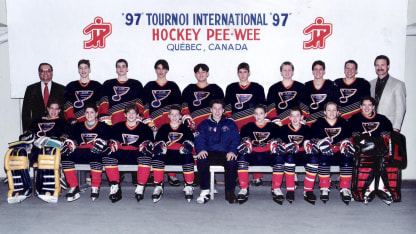
Nobody saw that explosive growth coming when the first group of children reported to a local outdoor rink to learn the intricacies of the game.
McKenna's father, Terry, now 66, was on that first organized team in 1961.
Terry McKenna's coach was Ed Olson, who played for the St. Louis Flyers from 1946-50 and settled in the area at the end of his career. He eventually took on the task of introducing the game he played as a kid in his native Michigan to the children of St. Louis.
"If I had to pick one person to be the father of youth hockey in St. Louis, it would be Olson," Terry McKenna said. "I still think of Olson being behind the bench at Kirkwood [ice rink] and bellowing, 'Can't anybody play this game?'"
The answer then was a simple and unequivocal "no," with only the transplants who arrived from places further north able to play with any sort of proficiency.
But eventually, a tidal wave of talent was developed from those humble beginnings at the outdoor rink over which Olson presided.
Terry McKenna has ridden that hockey wave his entire life.
After blazing the youth hockey trail as a player, McKenna has been involved with amateur hockey as a coach, and professional hockey as an official scorer for the Blues, for much of his adult life.
His father, Bill, ran the Kirkwood Ice Rink and officiated local amateur games, and is a member of the St. Louis Amateur Hockey Hall of Fame.
His son Mike, 33, has played 22 NHL games with four teams and continues to chase his dream in the minors.
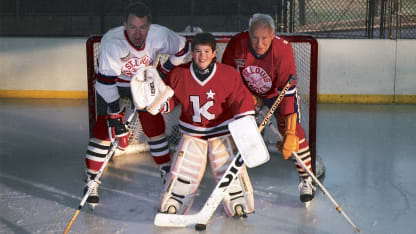
When Terry first put Mike on skates, there was no thought of it being the start of a process that would culminate with the NHL. Up to that point, such a journey was not completed by players from St. Louis.
Sure, Pat LaFontaine was born in St. Louis and became a Hockey Hall of Fame player, but he did not play the majority of his youth hockey there, having moved to Michigan when he was 7. In an odd twist, according to Terry McKenna, it was Bill McKenna who used to open the Kirkwood rink early so the young LaFontaine could get some extra ice time.
Ice is not at quite as much of a premium for the budding hopefuls of today. Thanks to the Blues and their commitment to nurturing the sport at the amateur level, the amount of available ice in the area has mushroomed. According to USA Hockey, there were 12 indoor rinks in greater St. Louis in 1976. Today, there are 25 indoor rinks, featuring 30 sheets of ice.
Occasionally, a player who called one of those sheets his home ice was good enough to play Division I college hockey or Canadian junior hockey, but the St. Louis area was never considered one of the hotbeds of the sport in the United States.
"For me, even college hockey was a far-off dream," said Mike McKenna, who played at St. Lawrence University from 2001-05. "We had no idea any of this was possible. We just played for the fun of it."
Throughout Missouri, young athletes dreamed of playing baseball for the Cardinals, or football for the University of Missouri and perhaps beyond.
Cam Janssen became the first St. Louis-trained player to make it to the NHL when he suited up for the New Jersey Devils during the 2005-06 season. He grew up in Eureka, Missouri, a small suburb 25 miles from the city.
Janssen dreamed of playing for the Blues, having fallen in love with the exploits of Hull and the rough-and-tumble escapades of bruising forwards Kelly Chase and Tony Twist.
But area coaches had other plans for Janssen.
"I'm from Eureka, Missouri; Eureka. I'm not supposed to play hockey, I'm supposed to play football, you know," Janssen said. "I played football just to become an athlete. I quit football because I had to go to hockey practice and that trumped football. But in the coaches' eyes, which is completely understandable, they didn't understand what I was doing. 'Oh, you are playing hockey? Hockey is not even a sport here.'
"It wasn't for them. Football was where you were going to go college, where you were going to go to Mizzou. 'You're a great athlete, Cam, you're going to be an inside linebacker and you are going to go to Mizzou.'"
But Janssen had his own path mapped. He was going to play in the NHL and, like so many other kids of his generation, he needed to find a way to navigate the dream planted by watching the Blues, particularly Hull.
The Golden Brett
It is impossible to tell the story of the growth of youth hockey in the St. Louis area without mentioning Hull, the high-scoring forward who dominated the city's sports scene for a decade.
Hull, the son of NHL legend Bobby Hull, arrived in St. Louis in a trade from the Calgary Flames on March 7, 1988. He had a NHL pedigree from his father but had yet to prove his credentials.
That all changed in St. Louis.
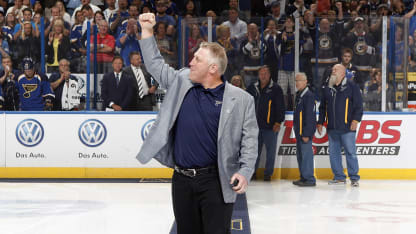
© Mark Buckner/Getty Images
In 1988-89, his first full season with the Blues, Hull scored 41 goals; a nice number but a mere harbinger of what was to come. In each of the next three seasons, Hull led the League in goals, putting up gaudy totals: 72, 86 and 70. In the history of the NHL, only Wayne Gretzky has scored more goals in one season than Hull's 86 in 1990-91. Gretzky scored 92 in in 1981-82 and 87 in 1983-84.
Hull's goal-scoring exploits and his larger-than-life personality immediately put him among the biggest sporting names in the city, joining Willie McGee, Ozzie Smith and Lee Smith of the Cardinals at the pinnacle of the superstar class.
"Hull was gigantic," Janssen says before breaking into a chuckle. "Him and his mullet."
Craig Janney was a teammate of Hull's from 1992 to 1995 and experienced Hull-mania firsthand.
"He was so big. He was couldn't-go-out-of-your-house-type big in St. Louis," Janney said. "He was that big in that town because it is a real small town. The years he was recording there were just out-of-this-world years. I think he brought [the media] there a lot to see his games, see him scoring. He just made hockey big in that town."
Hull's exploits inspired countless kids to pick up sticks and pester their parents to play hockey at the local rinks.
"Brett Hull was the beginning of youth hockey as we know it now in St. Louis," said Scott Rupp, president of the St. Louis Amateur Hockey Hall of Fame.
Said Terry McKenna: "He was the first totally electrifying player we had in St. Louis. You didn't know what he was going to do when he had the puck on his stick."
Almost overnight, kids everywhere in the region wanted to do everything the Golden Brett was doing.
After being exposed to the game through Hull, some youngsters gravitated to other players as role models.
Some wanted to be Hull, but others wanted to be the defenseman with the big shot and the high point totals like Al MacInnis. Those who liked to play with a bit of sandpaper wanted to be like two-way forward Brendan Shanahan. Janssen wanted to be like the man everyone called "Chaser," watching everything Chase did on the ice and putting his own spin on it. McKenna wanted to be Curtis Joseph, a stylish goaltender who played his first six NHL seasons with the Blues from 1989-95.
But how would those young athletes translate dreams of hockey greatness into reality?
The Alumni
In reality, it proved to be simple: The wannabes were introduced to the been-there-done-that set, and magic resulted. The union between aspiring hockey players and alumni of the Blues who had settled in the region formed the perfect environment to create elite players.
The Blues have one of the most vibrant alumni groups in the League. Many players find it unthinkable to leave the area once their playing days are over.
"Why would they?" Janssen said. "St. Louis is a great city to live in. It's cheap, the traffic isn't too bad, there's jobs and the alumni [are] incredible.
"People stay here because the city is great and the people never forget you if you bled for the city with one of the sports teams here. If you bleed for the hometown team, the people here will always remember that."
Hockey nomads from all over the world reported for NHL duty in St. Louis, fell in love with its Midwestern mores and never left. Many threw themselves headfirst into growing the game at the grass-roots level, paying forward the sport that had done so much for them.
They entered coaching, in large part, to instruct their own children. But countless other players benefited from their presence and the knowledge they could impart.
When Mike McKenna was 12, his youth coach was John Wensink, a no-nonsense forward who had been drafted by the Blues and played 403 NHL games for five franchises from 1973-83.
"When you skate on the ice and John Wensink is your coach and he played in the NHL for however many years and he tells you something, you are going to listen," McKenna said. "I can still remembering him asking us how do we pass the puck. 'Like a bullet and on the tape,' he would say."
A parade of former players like Wensink picked up whistles and whiteboards to pass the game on to the next generation. There was Blake Dunlop and Mike Zuke. Perry Turnbull and Basil McRae. Jeff Brown and Keith Tkachuk.

© Mark Buckner/Getty Images
Three former NHL players are coaching in the St. Louis Blues AAA setup. Chase, a stalwart with the Blues and Janssen's role model, is an assistant on the 2003 birth year team. Chris Pronger, a Hall of Fame defenseman, is listed as an assistant on the 2002 birth year team. Lubos Bartecko, a former Blues player who retired from European hockey in 2013, is an assistant on the Midget Major team.
"The NHL guys that have stayed in St. Louis and have gotten into coaching are driving the boat in St. Louis," Mike McKenna said. "That quality of coaching is what is behind what is happening now in St. Louis."
Coaches with NHL experience have become a calling card for the Blues AAA program, and the kids have responded enthusiastically, showing up in bigger and bigger numbers. The total number of youth players in the greater St. Louis area has grown 47 percent in the past decade, from 1,929 registered players to 2,837, according to USA Hockey.
The pipeline
Not only have the players shown up in larger numbers, but the quality of the individual players has grown noticeably.
At the start of the 21st century, a player from St. Louis occasionally found his way to the NHL.
McKenna and Janssen paved the way for others. Paul Stastny, who plays for the St. Louis Blues, and his brother Yan, who played for the Edmonton Oilers, Boston Bruins and the Blues, kept the pipeline going, following in the footsteps of their father, Peter Stastny, who finished a Hall of Fame playing career with a two-season stop in St. Louis.
Joe Vitale of the Detroit Red Wings and Brandon Bollig of the Calgary Flames made the long journey. Ben Bishop is the starting goalie for the Tampa Bay Lightning and was a backup for Team USA at the World Cup of Hockey 2016. Forward Pat Maroon, who began his youth hockey career in St. Louis on inline skates, is riding shotgun for Connor McDavid with the Oilers. Butler was with the Blues for part of this season but is now with the Chicago Wolves of the AHL.
More recently, players such as defenseman Scott Mayfield of the New York Islanders and forward Matt Tkachuk of the Flames reached the NHL.
Tkachuk, the son of NHL player Keith Tkachuk (who played for the Blues for nine seasons and coached in the AAA program) was one of the five St. Louis-area players selected in the first round of the 2016 NHL Draft.
Tkachuk, taken No. 6 by the Flames, was followed by Clayton Keller, selected No. 7 by the Arizona Coyotes, Logan Brown (No. 11) by the Ottawa Senators, Luke Kunin (No. 15) by the Minnesota Wild and Trent Frederic (No. 28) by the Boston Bruins.
All five players, as well as goalie Joseph Woll, selected in the third round (No. 62) by the Toronto Maple Leafs, played for the St. Louis Blues AAA program. St. Louis produced as many first-round picks as Sweden and Finland combined.
For those who had lived through the evolution of St. Louis amateur hockey, that 2016 draft was an unfathomable experience.
Rupp, 54, played youth and junior hockey in St. Louis before playing Division I hockey at Northern Arizona University. Few of his peers made it as far in the sport as he did at that time.
"Four kids from St. Louis went in the top 15, which at the time, was as many kids selected from here as from the whole country of Canada at that time in the round," Rupp said. "When they said Frederic's name [at No. 28], I started crying. That is how neat it was. To know where you come from and to see that happen is so cool."
Matthew Tkachuk already has arrived in the NHL; he has been a regular for the Flames right out of camp. Some of the others drafted in 2016 aren't far behind him. Others will join the crew of St. Louis-bred players in the next few drafts.
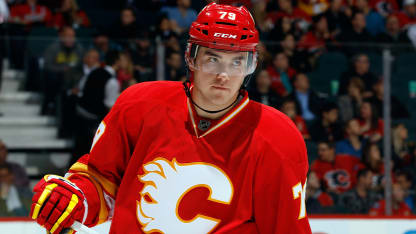
© Gerry Thomas/Getty Images
Butler, 30, has played 387 NHL games as a defenseman with the Buffalo Sabres, Flames and Blues. He knows the city's pipeline isn't drying up anytime soon.
In the summer, Butler skates and works out with professional players in the area as well as those on the cusp of joining the select, but ever-growing, group. Unlike Olson, Butler doesn't have to wonder if anyone can play the game. He knows they can; often as well or better than he could when he was their age.
"I'm blown away by the skill development of the kids that join on us on the ice," Butler said. "They can do things we didn't even think of doing when we were their age."
Janssen, who retired from hockey in August and hosts a radio sports-talk show in St. Louis, spent much of last summer skating with the players who were drafted in June and others who hope to be chosen in the next couple of years.
"When you skate with those kids, you better be on your game or they will make you look foolish," he said.
Those kids, who try to outshine their role models in the same way Janssen and others tried to outdo those who came before them, assure that the future of St. Louis hockey is even brighter than it will be when the Blues and the city take the spotlight on Jan. 2 at Busch Stadium.
"It's just further proof that hockey in St. Louis is here to stay," Butler says.
He can't believe how far the game has come in his city in his lifetime.
No longer do the youth teams travel to other hockey hotbeds and come home with their tails tucked. Instead, they go to places like Michigan and Minnesota, and throughout Canada, and come home with hardware and well-deserved respect.
The Blues are no longer a niche franchise with limited appeal. Instead, they share the media spotlight with the Cardinals.
Last spring, the Blues made it to the Western Conference Final, losing in six games to the San Jose Sharks. It was their first trip to the conference final since the 2000-01 season.
Now, the Blues will take the sport outdoors and capture the imagination of hockey fans and general sports fans from the city and beyond.
For those who made all of these things happen, Jan. 2 and the 2017 Winter Classic will be the latest benchmark of the growth of the game in their city.
"This game is so important to so many people in our city," Mike McKenna said. "My friends are over the moon about this game."

